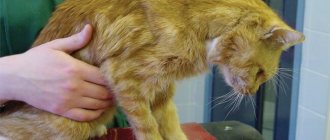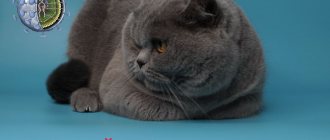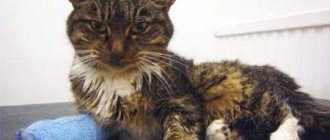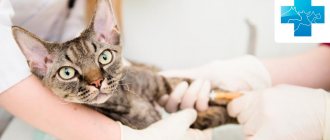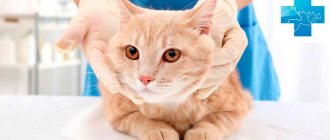Polycystic disease (from Latin polycystosis
, where
poly
is a set,
cystis
is a cyst - a hollow tumor with liquid contents) is a disease in which many cysts form in the kidneys. Over time, most of the kidney becomes a vesicular formation. This disease develops in both kidneys simultaneously, and the function of the kidneys to cleanse the blood of waste products is sharply reduced.
A veterinarian might write a diagnosis like this: “Autosomal dominant feline polycystic kidney disease (ADPKD).” In English, the disease sounds like Polycystic kidney disease (PKD).
Unfortunately, polycystic kidney disease is the most common inherited disease in cats. Cats of the Persian breed get sick most often - up to 38% of representatives worldwide! The risk group includes breeds in which the Persian cat was used: British Shorthair, Scottish Fold and Himalayan cat, as well as a number of related breeds (see table).
Table The incidence of polycystic kidney disease in different breeds of cats (according to the Russian Society of Veterinary Urologists)
| Cat Breeds with a High Chance of Developing Polycystic Kidney Disease | Cat Breeds at Moderate Risk for Polycystic Kidney Disease | Cat Breeds That Have a Low Chance of Developing Polycystic Kidney Disease |
| Persian cat Himalayan cat Exotic shorthair British shorthair | Bombay cat Asian tabby Burmilla Tiffany Burmese cat Cornish Rex Devon Rex Ragdoll Snowshoe | Abyssinian Angora Bali Bengal Burmese Egyptian Mau Korat Maine Coon Norwegian Forest Okikat Oriental Longhair Oriental Shorthair Russian Blue Siamese Singaporean Somali Tonkinese Turkish Van |
Polycystic kidney disease (PKD) is a hereditary disease, meaning cats cannot get it, but rather get it from their parents and are sick from birth. Unfortunately, PKD cannot be cured; you can only slow down the course of the disease by contacting a veterinary clinic as early as possible.
Causes of the disease
Veterinarians attribute the hereditary predisposition of some animals to the only cause of polycystic disease. The mechanism for the development of pathology is as follows: a certain gene responsible for protein synthesis is mutated. As a result, a cyst forms, growing and affecting healthy tissue.
Genes that provoke the disease can be passed on to a kitten by both the mother and the father. If both parents are carriers of pathological genes, then the offspring, as a rule, die in the womb.
Once born, the kitten gives the impression of being absolutely healthy for a long time, since the disease does not manifest itself in any way. Meanwhile, the pathology has already begun its destructive effect. Polycystic disease cannot be cured. The veterinarian’s task is to use treatment to stop the destructive process and thereby prolong the animal’s life.
How to diagnose
Palpation at an early stage rarely gives positive results, as the cat quickly gets used to the unpleasant sensations. Ultrasound gives the most detailed picture. With its help, you can see the existing tumor and assess the condition of the affected organ. By the age of 1 year, it acquires a bumpy outline, so it is recommended that pets at risk be examined for the first time at this time.
In addition to ultrasound, it is necessary to undergo blood and urine tests, as well as a biopsy to determine possible malignancy. Secondary urinary tract infections are detected by culture of kidney tissue samples. At an advanced stage, x-rays are used to make a diagnosis.
Some veterinary clinics can make an appointment for genetic testing. If you are not sure about the DNA of your pet’s parents, then thanks to this study, you can find out about the existing predisposition before the pathology worsens.
Main symptoms
The process of tissue replacement is very long and slow, so you can suspect polycystic disease in a cat no earlier than when he reaches 7 years of age. By this time, the cysts increase in size and occupy most of the kidneys, limiting their activity.
It is during this period that the first symptoms of polycystic disease are observed, which is often mistaken for renal failure.
The owner should be alert to such signs as:
- lethargy, low mobility;
- depressed state;
- weight loss associated with food refusal;
- vomit;
- frequent urination;
- increased thirst.
As the disease progresses, the symptoms become more pronounced and the pet’s condition worsens.
Prognosis for PEP in cats
The faster CRF progresses, the worse the prognosis for cats with PKD.
Aggravate the course:
- early development of the disease (up to 3 years);
- poor effect of drugs;
- frequent infections.
It should be remembered that there is no complete recovery from this disease. You should contact the clinic in a timely manner for a speedy diagnosis and treatment that will support the animal and correct its condition, prolonging life expectancy and improving its quality.
Treatment method and prognosis
Treatment of polycystic disease is complex, including surgery. Conservative therapy often does not produce results.
If the disease is detected at the initial stage, there is a chance to cure the animal, however, as practice shows, such cases are very rare. As mentioned above, polycystic disease occurs in a latent form for many years and diagnosis is carried out already at the second or third stage of the disease.
Thus, the goal of treatment is not to cure the animal, since this is no longer possible, but to ensure satisfactory well-being and prolong the life of the pet.
If the cysts occupy a large area and are large in size, the fluid is periodically removed from them using a puncture needle. To minimize chronic renal failure developing against the background of polycystic disease, drug therapy is indicated.
In order to prevent intoxication, rehydration detoxification is carried out - parenteral administration of rehydration solutions to remove toxins.
Stabilization of blood pressure is achieved with the help of the drug Amlodipine, as the most effective. The dosage and course are determined by the veterinarian.
As for the prognosis, veterinarians are cautious about it. The lifespan of animals with polycystic disease varies from two months to several years. When implementing maintenance therapy at the initial stage, the prognosis is favorable, in other cases it is negative or doubtful.
General information about the disease
Polycystic disease is a serious disorder that affects a kitten’s kidneys from a very early age. A characteristic feature of this disease is the appearance of small cysts filled with fluid in the kidney tissues. Gradually, the tumors grow, thereby replacing healthy cells. During the course of the disease, the cat’s body adapts to problems in the functioning of the infected organs, so signs of polycystic disease may be absent for a long time.
The following cat breeds are most often affected by polycystic disease:
- exotic shorthair;
- Persian;
- Himalayan;
- Scottish lop-eared;
- mixed breeds of the above breeds.
The complexity of the disease lies in the fact that the process of kidney damage by cysts is irreversible and it is constantly progressing. The size of the formations increases throughout the animal's life, leading to the development of renal failure. Although polycystic disease cannot be cured completely, therapeutic methods can slow down its progression if detected early.
Lack of treatment contributes to the development of complications as a result of kidney damage from cystic formations.
Complications of polycystic disease:
- renal failure;
- intoxication of the body;
- infection of the body by bacteria;
- sepsis;
- transformation of cysts into malignant neoplasms;
- death.
Despite the fact that polycystic disease most often affects purebred cats, any cat can suffer from this disease, regardless of breed, age and physiological characteristics.
What to do at home
The owner must follow the veterinarian's instructions. You cannot prescribe medications yourself, reduce or increase the dosage of medications!
Dietary nutrition is of great importance in the treatment process. Veterinarians recommend special medicinal wet food intended for animals with kidney pathologies. Such feeds are characterized by compositions with a reduced content of protein and phosphorus. It is these elements that provoke the development of symptoms of chronic renal failure.
Vitamin therapy is necessary. To normalize phosphorus-calcium metabolism, the cat should be given medications containing vitamin D.
Prevention
When crossing a sick individual with a healthy one, the probability of giving birth to infected kittens is 50%. Therefore, it is better to spay or neuter pets with polycystic disease to prevent further spread of the disease. If an animal has sick relatives, it must be systematically examined to exclude manifestations of the disease.
Preventive examinations of cats will help identify health problems in the early stages, thereby reducing the risk of severe complications.
What types are there?
Symptoms of polycystic disease in cats may vary, depending on the type of disorder. The table shows the main classification of the pathological process in the animal’s kidneys and a brief description:
| View | Peculiarities |
| Unilateral | The left or right internal organ is affected |
| Symptoms may not be observed for a long time, since one kidney functions normally and takes over the work of the patient | |
| The prognosis for this form of polycystic disease is more positive | |
| Double sided | Cysts form in both kidneys at the same time |
| In cats and cats, the process of urine excretion is completely disrupted | |
| Rapidly progressive intoxication of the body is noted | |
| This type of disease occurs with pronounced symptoms. |
They get sick much more often than ordinary cats.
It is unknown how long a cat with polycystic kidney disease will live, but it must be treated immediately. Persian cat breeds suffer from this disease. And often, a three to five year old animal is left without kidneys, in the full sense of the word. There is a tendency that purebred cats have a greater risk of getting sick than ordinary domestic cats. British cats suffer from diseases less frequently than their Persian counterparts. But don’t be surprised, because they are relatives.
What is the cause of this disease? First, hereditary characteristic disorders, above, as an example, we talked about the Persians. But, unfortunately, nothing has been revealed in veterinary practice yet about other factors. Doctors in this field of medicine suggest that an inherited factor and disease of the endocrine glands may also play a role. And this is also important in this process.
Some experts in veterinary medicine have proven that parathyroid hormone and vasopressin activate the growth and formation of cystic accumulations. But these assumptions are not fully substantiated.
© shutterstock
Important information for the owner
Polycystic kidney disease, unfortunately, is incurable. There is currently no real way to slow down the growth of cysts. Also, you cannot remove or puncture bubbles with liquid. Therefore, the owner must direct maximum efforts to ensure a painless and comfortable life for the pet.
To understand exactly how to help a pet with a terrible diagnosis, you need to understand the mechanism of kidney function. The vital paired organ helps control blood pressure by secreting a unique enzyme called renin. When blood pressure drops and organs don't get enough blood, renin is released, causing blood vessels to constrict. Once the blood vessels narrow, blood pressure will rise. Healthy kidneys filter toxins and excess water from the blood. Purified blood remains in the body, and waste leaves the body through urine. The kidneys also help maintain the proper balance of vitamins and minerals in the blood, including sodium, calcium, potassium and magnesium. But as the cysts grow, all of the above kidney functions will deteriorate significantly.
Therefore, it is important to reduce the level of toxins in your cat's body. You need to make sure that your pet does not come into contact with sick pets, eats simple but nutritious foods, and is also vaccinated against the most common infectious diseases. It is imperative to ensure that the animal’s diet contains foods low in protein and phosphorus. Of course, cats need protein for normal growth, muscle building and rapid repair of damaged tissue. But after the body processes the incoming protein, a waste product called urea is formed. Cats with kidney failure cannot quickly and without consequences completely get rid of this processed product.
Stages of polycystic disease
In cats, the following phases of the disease are distinguished:
- Early.
- Average.
- Advanced polycystic disease.
Early stage
Recognized by the following characteristics:
- The cat is lethargic.
- I feel satisfactory. Palpation of the abdomen causes pain.
- A standard urine test reveals minor abnormalities.
- Tonometry records the increase in blood pressure. This is the first characteristic sign of the presence of the disease.
Britons are more prone to polycystic disease
Middle stage
The kidneys cease to cope with the filtration of biological waste that has a toxic effect on the body. The concentration of bio-waste is increasing. The cat strives to expel toxic waste by any means. Therefore, vomiting occurs. To prevent the formation of toxins, it is necessary to stop eating, which the animal does. Liquid is needed to dilute the concentration of toxic substances and remove them with urine. Therefore, the animal drinks a lot and urinates often.
Since the kidneys are not able to perform their functions properly, toxins have an irritating effect on nerve receptors. Therefore, convulsions occur, turning into seizures similar to epileptic ones.
The cat has seizures
You can speed up the elimination of toxins in case of defective kidneys by increasing the speed of blood flow. This is achieved by increasing blood pressure. This condition is fraught with the development of a stroke.
Excessive blood pressure has an adverse effect on the retinal vessels, so the animal develops ophthalmological pathologies - changes in the size of the pupils, decreased visual acuity.
The cat’s attempts to quickly remove toxic substances cause tension in all body systems, which is accompanied by hyperthermia. A responsible fellinologist must have an idea of what temperature a cat is considered normal and how to take measurements.
Hyperthermia may be a reaction to inflammation of the urinary tract. A weakened body is not able to resist secondary infections, which is why cystitis and other types of infectious diseases of the urinary tract occur.
Cat with sick kidneys
Advanced polycystic disease
In addition to the above pathological changes, additional ones are observed:
- The urine becomes cloudy, taking on the appearance of meat slop.
- Oligouria develops, or, conversely, polyuria.
- High concentrations of proteins, leukocytes, red blood cells, and urinary casts are found in the urine.
- Blood tests reveal symptoms of anemia when the amount of nitrogenous waste increases.
Secondary infections are severe. There is a high probability of transformation of a cystic vesicle into a malignant tumor.
Keeping a sick animal
Pets with this diagnosis do not require special living conditions. It is important to follow the diet prescribed by your veterinarian. It is best to feed your four-legged pet with ready-made medicated food. If this is not possible, let’s use a natural diet. It should not contain too high-calorie, fatty foods. Free access to clean drinking water around the clock is an important point.
The owner of a sick cat needs to monitor his drinking regime. If he drinks little water, it is recommended to switch him to canned wet medicated food. The animal must be shown to the veterinarian monthly in order to promptly identify the deterioration of its condition and take appropriate measures.

